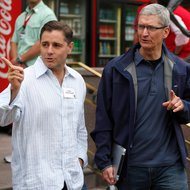“People are driving and all of a sudden they run into a Caribbean station,” said Jason Finkelberg, the station’s general manager, describing the listener complaint that constantly bedevils K104.7.
It is not some quirk of the dial, or a blip in the airwaves. The Caribbean music that bleeds into the Top 40 sounds came from the Bronx and Brooklyn version of 104.7, the FM frequency on which a pirate radio station, 104.7 the Fire Station, has squatted for at least the past decade. It has colorful DJs, live special guests, commercials and devoted listeners. What it does not have is a Federal Communications Commission license for its frequency.
At the moment, it is also off the air, after two of its operators, DJ Fresh Kid and Solomon Malka, were arrested last week on charges of unauthorized radio transmission. Police detectives, accompanied by an F.C.C. engineer, raided their studios, seized their equipment and forced a shutdown.
But dislodging pirate radio operators from the airwaves may be no more useful an exercise than playing Whac-A-Mole: dozens, if not hundreds, of underground radio operators crowd the FM dial in New York, mainly in neighborhoods like Flatbush, Brooklyn, where immigrant communities clamor to hear dance hall and soca Caribbean music and news from home.
Some flicker on and off, beholden to no set schedule and no one frequency; others are more established operations, with Web sites, revenue from commercials and fan bases. The Fire Station had regular shows and ran around the clock on weekends, playing in the afternoons and evenings during weekdays.
If this is not quite the stuff of outlaw fantasy, as depicted in the movie “Pirate Radio,” the operators often claim that they are giving underserved communities a voice that they cannot find elsewhere. It is the kind of programming that cannot be heard on mainstream radio stations in the city.
“The message that we’re trying to bring across is we are people who have great ideas, who are independent, and there’s a lot more to offer than the big-time radio stations have to offer,” said Timo Flex, a manager at VYBZ Radio, a reggae and soul station. He said the station broadcasts only online, but it and its frequency, 107.1, have been mentioned as being run by pirates on local Web sites and radio message boards.
“There are things going on in the community we wish to share in the world,” he said. “It’s not just local vibe. It’s local vibe community radio.”
Transmission equipment is cheaper and easier to set up than ever before, said Allan Sniffen, a radio worker-turned-dentist who has run a message board about New York-area radio since 1997.
“Used to be, 30, 40 years ago, you had to be an engineer. Now it’s pretty much plug and play as far as this stuff goes, and anyone can do it,” he said, estimating the cost of setting up a station at less than $500. He said weak enforcement from the F.C.C., which controls licensing, has meant a proliferation of the tiny stations. “It’s like you have a 55-mile-per-hour speed zone and everyone goes 80 miles an hour, ’cause they know police never patrol the area.”
Obtaining a new license in the city is nearly impossible because most of the city’s frequencies are already licensed, he said; buying a radio station and its license outright can cost millions.
The F.C.C. mainly responds to complaints, though it occasionally scans frequencies known to host pirates, using direction-finding equipment to track down the signal. Fines can run as high as $16,000 for each violation or each day of a violation, a spokesman said.
New York State has had the most F.C.C. enforcement activity of any state since 2003, with about 23 percent of all activity, according to an online database maintained by the agency. (The next most pirate-packed state is Florida.)
Add Mr. Malka, 51, and DJ Fresh Kid — whose real name is Seon Bruce, 40 — to the list. The Brooklyn district attorney’s office said detectives set up an undercover sting operation for the underground DJ by buying airtime for a commercial, then tuned in to confirm that the commercial was playing at the appointed time on 104.7. The detectives were directed to deliver $500 in cash to a barbershop on Nostrand Avenue; it is unclear what the faux commercial purported to sell.
Detectives tracked the radio signal for 104.7 to a room on the rooftop of 30 Broad Street, a 50-story building in Lower Manhattan. They also found transmitting equipment for another frequency, 91.7 FM, on the roof of 611-615 East 76th Street in Brooklyn, on the border between East Flatbush and Canarsie.
Neither Mr. Malka nor Mr. Bruce could be reached for comment.
But Caribbean music fans may have hope yet.
“As quick as they can shut them back down, they pop back up in a different building,” Mr. Finkelberg said. “I hope not, but I would not be surprised if they were back on Monday somewhere.”

Article source: http://www.nytimes.com/2013/07/05/nyregion/radio-pirates-of-the-caribbean-no-less-are-pulled-off-the-air.html?partner=rss&emc=rss



